Essays: PAHSA Okinawa Short Program
The Graduate School of International Cultural Studies, Meio University, Okinawa, Japan, hosted a short-term study program for 10 international PAHSA students in August 2012. There were classroom lectures and also study trips to places of interest. Students were able to gain new perspectives from the visits and through speaking to people involved in activities on the ground. Below are some of the reports written by PAHSA students on the program.
Okinawa Study Program Report
PAYAP University, Thailand
The two-week Okinawa short-term study program on Peace and Human Security in Asia (PAHSA) from August 6-20, 2012, was very comprehensive and provided great insight, knowledge, and many new experiences for participants. In addition to the theme of peace and human security, the program also focused on Okinawa’s history, politics, economic and socio-cultural issues, and in particular, the current situation of the U.S. military bases in the prefecture.
PAHSA cornerstone Peace is not merely the absence of war, and human security has transcended beyond the traditional dimensions. The Japanese government has played a crucial role both bilaterally and multilaterally in building and maintaining peace and advocating human security in the region and the world. Its foreign policy has incorporated peace building and human security as one of its core components and so does its official development assistance to developing countries.
Politically, Okinawa prefectural government has a degree of authority prescribed by central government and it is said that there is equal authority over decision-making. Yet national policy is sometimes formulated and implemented by central government with scant regard for the people of Okinawa. Critics argue that these decisions are made by a Diet (the Japanese Parliament) a great distance away in Tokyo and it is disconnected from the people of Okinawa.
Okinawa’s economy has progressed noticeably in the last few decades, and a middle-income class has emerged. Central government spending from Tokyo, tourism, and military bases are the three main pillars of the economy locally. Positively, the economy of the prefecture is fairly resilient to regional and global trends thanks to the continued contribution from Tokyo and from the bases. However, income is distributed disproportionately between the owners and non-owners of property and this leads to a degree of polarization in society.
Due to the historical legacy, Okinawa’s culture is said to be a mixture of that found in China, Japan, and the United States. Historically though, Okinawa’s culture has much in common with that found in China. This is not surprising given the former ties, both diplomatic and commercial, that date back to the period of the Ryukyu Kingdom. Nowadays, in spite of being a Japanese prefecture, Okinawa is distinct from the mainland in many aspects, culturally, in its traditions, in the ways of life of the people.
The Okinawa prefecture is regarded as a strategic location for U.S. military bases in the Asia Pacific. Proponents of the bases claim they help maintain peace and stability in the region and are key for Japan’s security because of the role that they play in the U.S.-Japan Strategic Alliance. Yet in spite of the economic interests provided by the U.S. bases, many Okinawa people share a negative sentiment and many seek to reduce the social burden caused by the large overseas military presence. However, geopolitical security in the region, including a nuclearized Korean Peninsula, the rise of China, the Taiwan issue, and local maritime disputes challenge many arguments that might be put forward for the displacement of military bases.
For a student keen to make a difference in the world, the PAHSA Okinawa program was truly worthwhile and the Japanese University Consortium deserves praise for initiating and organizing such a valuable exchange program. The Japanese people who did so much to welcome all of us and to promote mutual understanding also deserve enormous credit. Because of these efforts, we left Okinawa with a feeling that we had a greater understanding of peace and human security and were better prepared to play our part in its enhancement in the region, and on the larger world stage.
PAHSA cornerstone Peace is not merely the absence of war, and human security has transcended beyond the traditional dimensions. The Japanese government has played a crucial role both bilaterally and multilaterally in building and maintaining peace and advocating human security in the region and the world. Its foreign policy has incorporated peace building and human security as one of its core components and so does its official development assistance to developing countries.
Politically, Okinawa prefectural government has a degree of authority prescribed by central government and it is said that there is equal authority over decision-making. Yet national policy is sometimes formulated and implemented by central government with scant regard for the people of Okinawa. Critics argue that these decisions are made by a Diet (the Japanese Parliament) a great distance away in Tokyo and it is disconnected from the people of Okinawa.
Okinawa’s economy has progressed noticeably in the last few decades, and a middle-income class has emerged. Central government spending from Tokyo, tourism, and military bases are the three main pillars of the economy locally. Positively, the economy of the prefecture is fairly resilient to regional and global trends thanks to the continued contribution from Tokyo and from the bases. However, income is distributed disproportionately between the owners and non-owners of property and this leads to a degree of polarization in society.
Due to the historical legacy, Okinawa’s culture is said to be a mixture of that found in China, Japan, and the United States. Historically though, Okinawa’s culture has much in common with that found in China. This is not surprising given the former ties, both diplomatic and commercial, that date back to the period of the Ryukyu Kingdom. Nowadays, in spite of being a Japanese prefecture, Okinawa is distinct from the mainland in many aspects, culturally, in its traditions, in the ways of life of the people.
The Okinawa prefecture is regarded as a strategic location for U.S. military bases in the Asia Pacific. Proponents of the bases claim they help maintain peace and stability in the region and are key for Japan’s security because of the role that they play in the U.S.-Japan Strategic Alliance. Yet in spite of the economic interests provided by the U.S. bases, many Okinawa people share a negative sentiment and many seek to reduce the social burden caused by the large overseas military presence. However, geopolitical security in the region, including a nuclearized Korean Peninsula, the rise of China, the Taiwan issue, and local maritime disputes challenge many arguments that might be put forward for the displacement of military bases.
For a student keen to make a difference in the world, the PAHSA Okinawa program was truly worthwhile and the Japanese University Consortium deserves praise for initiating and organizing such a valuable exchange program. The Japanese people who did so much to welcome all of us and to promote mutual understanding also deserve enormous credit. Because of these efforts, we left Okinawa with a feeling that we had a greater understanding of peace and human security and were better prepared to play our part in its enhancement in the region, and on the larger world stage.
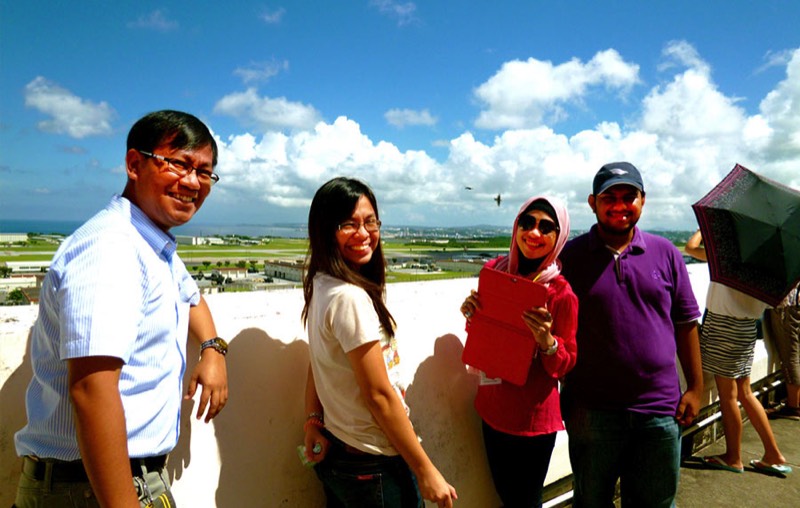
PAHSA students overlooking the Marine Corps Air Station Futenma located in Ginowan City, Okinawa
Okinawa's Living Culture
De La Salle University, the Philippines
The Okinawa Short-Term Study Program shed light on the prefecture’s culture, history, environment, and the other issues and differences from the Japanese mainland. As student of Japanese studies in my university, I was somewhat myopic, just familiar with Japan’s mainland culture, history and politics. This program allowed me to experience Okinawa’s uniqueness, its living culture.
The study program started with various lectures covering the prefecture’s local culture, history, and issues surrounding the U.S. military bases. The advantages and disadvantages of hosting the bases were also discussed in depth. Roundtable discussions spearheaded by the program coordinators and professors from different universities served as a springboard for sharing ideas and knowledge, this continued even after the sessions concluded. Aside from the lectures given at Meio University, the field trips around Okinawa provided context for the theoretical sessions. The study team visited many places of interest, such as the Okinawa Prefectural Museum and Art Museum, and the Okinawa Peace Memorial Museum. From these trips, students were able to understand the roots of the prefecture’s culture and history by incorporating what they had learned from lectures with what they saw for themselves.
On the study tour, students experienced Okinawa’s cultural heritage firsthand; the Ryukyu dance presentation and Karate exhibition were examples of this. The teachers did not only explain their history and show how things were done, but they also encouraged participation. We learnt how to move in full costume with accompanying music, and also conduct routines of kicks and punches as directed by the karate masters. Students also explored the Yanbaru trails in the north of Okinawa. This was particularly educational. On the way, we were able to interact with Okinawan activists from the Takae village who oppose the construction of U.S. helipads in the area. They explained their viewpoint, and stressed the hazards, such as noise and air pollution, and the danger of low-flying aircraft that the helipads would bring to the village. Their dedication is admirable, especially as four campaigners man a round-the-clock camp in protest; such is the belief in their cause.
Although it was not possible to go inside the Futenma and Kadena Air Bases, they could still be viewed from nearby rooftops. The scene of Futenma Air Base as seen from Okinawa International University was one of intense activity. There were frequent aircraft takeoffs and landings, an interment barrage of noise, and the smell of jet fuel assaulted the senses. It is plain that local people might feel oppressed by this level of military activity on their doorstep.
As students coming from different parts of Asia, the program served as a great opportunity to learn from the insights and experience that the study tour offered. The diversity of our cultures did not clash, but we were unified by the knowledge that we shared and discovered courtesy of the program.
The study program started with various lectures covering the prefecture’s local culture, history, and issues surrounding the U.S. military bases. The advantages and disadvantages of hosting the bases were also discussed in depth. Roundtable discussions spearheaded by the program coordinators and professors from different universities served as a springboard for sharing ideas and knowledge, this continued even after the sessions concluded. Aside from the lectures given at Meio University, the field trips around Okinawa provided context for the theoretical sessions. The study team visited many places of interest, such as the Okinawa Prefectural Museum and Art Museum, and the Okinawa Peace Memorial Museum. From these trips, students were able to understand the roots of the prefecture’s culture and history by incorporating what they had learned from lectures with what they saw for themselves.
On the study tour, students experienced Okinawa’s cultural heritage firsthand; the Ryukyu dance presentation and Karate exhibition were examples of this. The teachers did not only explain their history and show how things were done, but they also encouraged participation. We learnt how to move in full costume with accompanying music, and also conduct routines of kicks and punches as directed by the karate masters. Students also explored the Yanbaru trails in the north of Okinawa. This was particularly educational. On the way, we were able to interact with Okinawan activists from the Takae village who oppose the construction of U.S. helipads in the area. They explained their viewpoint, and stressed the hazards, such as noise and air pollution, and the danger of low-flying aircraft that the helipads would bring to the village. Their dedication is admirable, especially as four campaigners man a round-the-clock camp in protest; such is the belief in their cause.
Although it was not possible to go inside the Futenma and Kadena Air Bases, they could still be viewed from nearby rooftops. The scene of Futenma Air Base as seen from Okinawa International University was one of intense activity. There were frequent aircraft takeoffs and landings, an interment barrage of noise, and the smell of jet fuel assaulted the senses. It is plain that local people might feel oppressed by this level of military activity on their doorstep.
As students coming from different parts of Asia, the program served as a great opportunity to learn from the insights and experience that the study tour offered. The diversity of our cultures did not clash, but we were unified by the knowledge that we shared and discovered courtesy of the program.
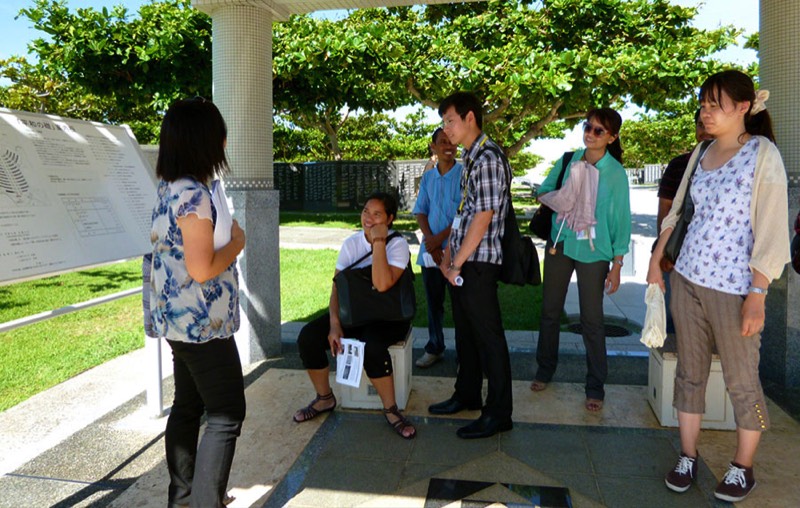
Okinawa Memorial: Conveying the spirit peace
Enhancing Mutual Understanding
Nanyang Technological University, Singapore
The program in Okinawa has provided an opportunity for attendees to understand the values that underpin Japan’s international strategy and set its diplomatic agenda. Human security has characterized Japanese foreign policy since the 1990s; it was one of the first Asian countries to embrace and promote the concept. The human security sessions of the Okinawa program demonstrated how human security has been perceived and operationalized in Japan’s engagement with the international community.
Compared to the Western perspective that emphasizes the physical security dimension, the Japanese concept of human security prioritizes the developmental aspect. Official development assistance has been a key tool for Japan to establish and expand relations with other countries and promote the values that it believes in. These include democracy, good governance, and the rule of law. Understanding the Japanese perspective of human security is helpful for understanding the human security discourse at an international level given Japan’s substantial contribution in its promotion.
The U.S.-Japan Strategic Alliance and the U.S. bases in Okinawa were the issues central to the discussions throughout the program. The strategic importance of the U.S.-Japanese alliance for the security of Japan as well as for maintaining the United States interests in East Asia has left the U.S. military bases issue a contentious point between and among the United States, the Japanese government, and the local community. Environmental, health, social and economic problems arising from the bases over the years, such as pollution and noise from flight training, have presented challenges to the well-being of the local community. The compound impacts of the U.S. military presence in Okinawa provides an interesting perspective while examining the base issue. These include non-traditional security (NTS), challenges arising from the traditional security needs, and non-traditional security issues in the Asia-Pacific. The base issue has also presented new questions, such as what is security, security for whom, and how might genuine security be realized for all people.
Exposure to the history and culture of Okinawa helps the observer to understand the individuals’ reasons and their motivation behind protests. The pursuit of autonomy and rights for their own homeland has sustained the protest movements through the years. Perhaps the success and failure of Okinawan social movements can provide lessons for rights movements in other countries.
Conversations with Japanese scholars, foreign Japan experts, and program participants have inspired a broader view from the course attendees. Undoubtedly, the insight offered from these academics, as well as views from other participants, have prompted the consideration of Sino-Japanese relations and security in East Asia from new perspectives.
For the students attending the program, it served as a platform for enhancing mutual understanding between China and Japan as well providing new perspectives on the wider stage of East Asia.
Compared to the Western perspective that emphasizes the physical security dimension, the Japanese concept of human security prioritizes the developmental aspect. Official development assistance has been a key tool for Japan to establish and expand relations with other countries and promote the values that it believes in. These include democracy, good governance, and the rule of law. Understanding the Japanese perspective of human security is helpful for understanding the human security discourse at an international level given Japan’s substantial contribution in its promotion.
The U.S.-Japan Strategic Alliance and the U.S. bases in Okinawa were the issues central to the discussions throughout the program. The strategic importance of the U.S.-Japanese alliance for the security of Japan as well as for maintaining the United States interests in East Asia has left the U.S. military bases issue a contentious point between and among the United States, the Japanese government, and the local community. Environmental, health, social and economic problems arising from the bases over the years, such as pollution and noise from flight training, have presented challenges to the well-being of the local community. The compound impacts of the U.S. military presence in Okinawa provides an interesting perspective while examining the base issue. These include non-traditional security (NTS), challenges arising from the traditional security needs, and non-traditional security issues in the Asia-Pacific. The base issue has also presented new questions, such as what is security, security for whom, and how might genuine security be realized for all people.
Exposure to the history and culture of Okinawa helps the observer to understand the individuals’ reasons and their motivation behind protests. The pursuit of autonomy and rights for their own homeland has sustained the protest movements through the years. Perhaps the success and failure of Okinawan social movements can provide lessons for rights movements in other countries.
Conversations with Japanese scholars, foreign Japan experts, and program participants have inspired a broader view from the course attendees. Undoubtedly, the insight offered from these academics, as well as views from other participants, have prompted the consideration of Sino-Japanese relations and security in East Asia from new perspectives.
For the students attending the program, it served as a platform for enhancing mutual understanding between China and Japan as well providing new perspectives on the wider stage of East Asia.
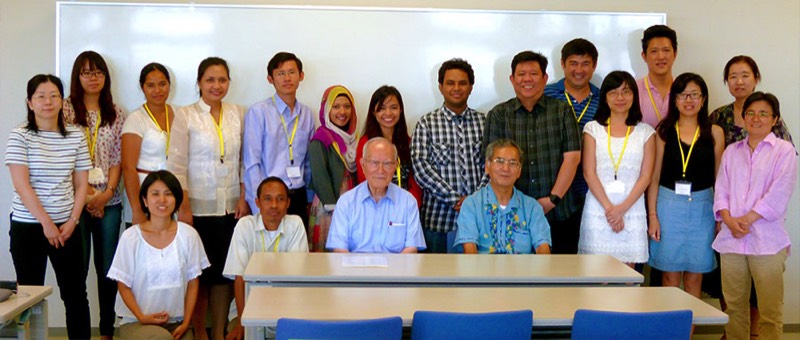
Students from Southeast Asia and professors at Meio University
The Key Essence: Change
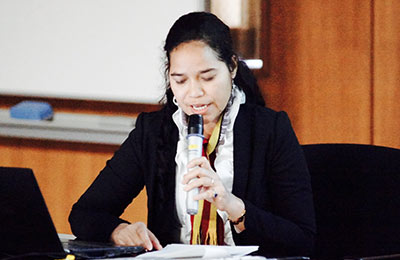
Universidade Nasional Timor Leste
The key essence of the JUC-PAHSA program on peace building and human security in Asia that took place at Meio University, Okinawa, Japan, might be summed up in one word; change. Change is seen when peace building takes place, but change is multifaceted and affects people on many levels. Change is itself a dynamic process. The PAHSA program at Meio University provided the opportunity for students to understand the dynamics of the process of change and to develop a greater awareness of the effect of change on peoples’ lives.
There were 10 students on the program who represented their institutions in Southeast Asia. The countries and their universities were varied; from China and Japan in East Asia; to East Timor, the Philippines, Indonesia, Singapore and Cambodia in Southeast Asia. Many students were newcomers to Japan, and for a number of them, it was the first opportunity to work, learn, and share opinions with a diverse group in an international setting.
While working together, the program offered us the space to gain perspectives on peace and human security issues, Okinawa’s history, its development, and the peace-building efforts that have taken place on the island. Coming from the relatively small island of Timor-Leste in Southeast Asia, the breath of opinion and knowledge provided by the multi-national students and professors was varied and will surely prove valuable in the years ahead.
In terms of conflict prevention and transformation, as the only part of Japan to have experienced ground combat in World War II, Okinawa prefecture suffered the loss of countless lives as well as valuable culture heritage. This might go some way to explain the overwhelming sentiment of the local people, that of peace and no more war. But since the United States has made Okinawa the site of expansive military bases, this presence sits uneasy with many Okinawans. There’s also palpable exasperation over land acquisition by the U.S. military in Okinawa and a feeling that the human rights of local people are being violated. This has led to large-scale protests in the past and at times a ‘land struggle.’ So by seeking to share its bitter lessons of the past as well as the struggles in the present, Okinawa’s message to the world today is about understanding issues and building the ‘cornerstones of peace.’
The unhappiness felt by many Okinawans over U.S. military bases is a thorny problem for the Japanese government to solve. The U.S.-Japan Security Alliance allows the U.S. military continued allocation of land in Okinawa for bases and training, and unquestionably, these installations are of great importance for the security of the country. Yet the Okinawa people are feeling powerless somehow; they have little role in the decision-making that takes place in regards to these installations. It is often stated that others make choices that affect their lives, and these judgments are made with little sensitivity for the feelings of locals. Given the history of Okinawa this is rather ironic. Conflict resolution and peace building courses though the veins of society in Okinawa. Yet the local people are unable to have access to the platform that makes the decisions that ultimately affect them, the people that live there, and this greatly impacts their notion of human security.
Complicating matters further is the unique temperament and spirit of the Okinawans. Mainland Japan has not experienced the same influences as Okinawa and the belief system differs somewhat from the mainland. China has proffered great influence over the island in the past and former ties date back many centuries. This is reflected in the perception and ways of communication for the local people, how their feelings are expressed, and how open conflict is avoided. This could sometimes deepen the mistrust with decision-makers, Japanese politicians, who sometimes might overlook the complexity of the culture in Okinawa when decisions are made in distant Tokyo.
Given a cursory glance, an onlooker might think that my home, Timor-Leste, has little in common with Okinawa. They are geographically and developmentally very distant from each other. Yet for each, history and experience has taught the people the importance of peace building and human security. Both Timor-Leste and Okinawa have experienced violence and the loss of life in the past, each has felt the heavy hand of the power of others, and each has a strong sense of wishing to control their own destiny as time moves forward. In short, each has seen great change, both positive and negative. Of course, Okinawa is in a different stage of development to Timor-Leste, but this means Timor-Leste can look to Okinawa and learn much. The JUC-PAHSA short-term study program offered our small group of international students a window to the valuable experience of the Okinawans. We will take away a little of the spirit of the Okinawan people and go back to our own countries and strive for positive change of our own.
There were 10 students on the program who represented their institutions in Southeast Asia. The countries and their universities were varied; from China and Japan in East Asia; to East Timor, the Philippines, Indonesia, Singapore and Cambodia in Southeast Asia. Many students were newcomers to Japan, and for a number of them, it was the first opportunity to work, learn, and share opinions with a diverse group in an international setting.
While working together, the program offered us the space to gain perspectives on peace and human security issues, Okinawa’s history, its development, and the peace-building efforts that have taken place on the island. Coming from the relatively small island of Timor-Leste in Southeast Asia, the breath of opinion and knowledge provided by the multi-national students and professors was varied and will surely prove valuable in the years ahead.
In terms of conflict prevention and transformation, as the only part of Japan to have experienced ground combat in World War II, Okinawa prefecture suffered the loss of countless lives as well as valuable culture heritage. This might go some way to explain the overwhelming sentiment of the local people, that of peace and no more war. But since the United States has made Okinawa the site of expansive military bases, this presence sits uneasy with many Okinawans. There’s also palpable exasperation over land acquisition by the U.S. military in Okinawa and a feeling that the human rights of local people are being violated. This has led to large-scale protests in the past and at times a ‘land struggle.’ So by seeking to share its bitter lessons of the past as well as the struggles in the present, Okinawa’s message to the world today is about understanding issues and building the ‘cornerstones of peace.’
The unhappiness felt by many Okinawans over U.S. military bases is a thorny problem for the Japanese government to solve. The U.S.-Japan Security Alliance allows the U.S. military continued allocation of land in Okinawa for bases and training, and unquestionably, these installations are of great importance for the security of the country. Yet the Okinawa people are feeling powerless somehow; they have little role in the decision-making that takes place in regards to these installations. It is often stated that others make choices that affect their lives, and these judgments are made with little sensitivity for the feelings of locals. Given the history of Okinawa this is rather ironic. Conflict resolution and peace building courses though the veins of society in Okinawa. Yet the local people are unable to have access to the platform that makes the decisions that ultimately affect them, the people that live there, and this greatly impacts their notion of human security.
Complicating matters further is the unique temperament and spirit of the Okinawans. Mainland Japan has not experienced the same influences as Okinawa and the belief system differs somewhat from the mainland. China has proffered great influence over the island in the past and former ties date back many centuries. This is reflected in the perception and ways of communication for the local people, how their feelings are expressed, and how open conflict is avoided. This could sometimes deepen the mistrust with decision-makers, Japanese politicians, who sometimes might overlook the complexity of the culture in Okinawa when decisions are made in distant Tokyo.
Given a cursory glance, an onlooker might think that my home, Timor-Leste, has little in common with Okinawa. They are geographically and developmentally very distant from each other. Yet for each, history and experience has taught the people the importance of peace building and human security. Both Timor-Leste and Okinawa have experienced violence and the loss of life in the past, each has felt the heavy hand of the power of others, and each has a strong sense of wishing to control their own destiny as time moves forward. In short, each has seen great change, both positive and negative. Of course, Okinawa is in a different stage of development to Timor-Leste, but this means Timor-Leste can look to Okinawa and learn much. The JUC-PAHSA short-term study program offered our small group of international students a window to the valuable experience of the Okinawans. We will take away a little of the spirit of the Okinawan people and go back to our own countries and strive for positive change of our own.

“Okinawa and East Timor have things in common”
Perceptions Cloud Complex Issues
Nanyang Technological University, Singapore
The Okinawa program is one of the most impressive and interesting programs I have ever attended during my study life. Before coming to Okinawa, I only imagined a beautiful Japanese island, yet there was much more to learn. The program covered lectures on human security and there were field trips to forests, other threatened habitat and museums. These offered students the opportunity to understand the local culture at a much more profound level, particularly so in the traditions of the people and also in the historical perspective for islanders. It was soon clear that my earlier perceptions were somewhat skewed and superficial in regards to Okinawa.
Perhaps most significantly, the Okinawa program provided program participants an opportunity to come to understand the current Asia Pacific security issues more deeply. These issues are key to many of the human security debates currently high on the agenda locally, nationally, and regionally. We learned that the U.S.-Japan Strategic Alliance allows continued presence of U.S military forces on Japanese territory, including Okinawa while the U.S. has continued to hold and use its bases that were secured under occupation after WWII. In addition, there is also a ‘marginalization’ of Okinawa by the Japanese mainland and locally the feeling of a ‘colonial relationship’ still pervades and this is compounded today with the large U.S. military presence.
PAHSA natural environment Near some bases, the U.S. military activity brings with it a multitude of problems. Apart from constant noise, the construction work of facilities has destroyed the natural environment and degraded the invaluable biodiversity including the endangered species in Okinawa. The maintenance of military facilities such as aircraft and other military vehicles have caused contamination of air, soil, and groundwater. Besides this, the Okinawa people have also experienced cases of U.S. military-caused accidents and crimes, some of which are violent and sexual in nature.
Plagued by these issues, the Okinawa people have struggled to build capacity to end the military occupation near their homes. The dogged protests that take place are impressive. Some local people are single-minded in their determination to have their voices heard. When our study group went to the Yanbaru forest area, there was a round-the-clock protest against deforestation because of the construction of military facilities. The Takae people are enduring a sit-in protest in front of the U.S. military base to try to stop construction of new helipads in their village. Their perseverance was incredibly inspiring. The Okinawa people’s anti-base movement made me think more deeply about the civil movements in my own country. By comparing these, I began to become much more interested in investigating these at a deeper level.
To summarize, the Okinawa program is interesting, instructive, and enlightening. It accommodates students from various Southeast Asian countries enabling different nationalities to bring different viewpoints to the discussion table. By attending this program, we have made new friends and enlarged our academic network, which will be very important for our future study and research.
Perhaps most significantly, the Okinawa program provided program participants an opportunity to come to understand the current Asia Pacific security issues more deeply. These issues are key to many of the human security debates currently high on the agenda locally, nationally, and regionally. We learned that the U.S.-Japan Strategic Alliance allows continued presence of U.S military forces on Japanese territory, including Okinawa while the U.S. has continued to hold and use its bases that were secured under occupation after WWII. In addition, there is also a ‘marginalization’ of Okinawa by the Japanese mainland and locally the feeling of a ‘colonial relationship’ still pervades and this is compounded today with the large U.S. military presence.
PAHSA natural environment Near some bases, the U.S. military activity brings with it a multitude of problems. Apart from constant noise, the construction work of facilities has destroyed the natural environment and degraded the invaluable biodiversity including the endangered species in Okinawa. The maintenance of military facilities such as aircraft and other military vehicles have caused contamination of air, soil, and groundwater. Besides this, the Okinawa people have also experienced cases of U.S. military-caused accidents and crimes, some of which are violent and sexual in nature.
Plagued by these issues, the Okinawa people have struggled to build capacity to end the military occupation near their homes. The dogged protests that take place are impressive. Some local people are single-minded in their determination to have their voices heard. When our study group went to the Yanbaru forest area, there was a round-the-clock protest against deforestation because of the construction of military facilities. The Takae people are enduring a sit-in protest in front of the U.S. military base to try to stop construction of new helipads in their village. Their perseverance was incredibly inspiring. The Okinawa people’s anti-base movement made me think more deeply about the civil movements in my own country. By comparing these, I began to become much more interested in investigating these at a deeper level.
To summarize, the Okinawa program is interesting, instructive, and enlightening. It accommodates students from various Southeast Asian countries enabling different nationalities to bring different viewpoints to the discussion table. By attending this program, we have made new friends and enlarged our academic network, which will be very important for our future study and research.
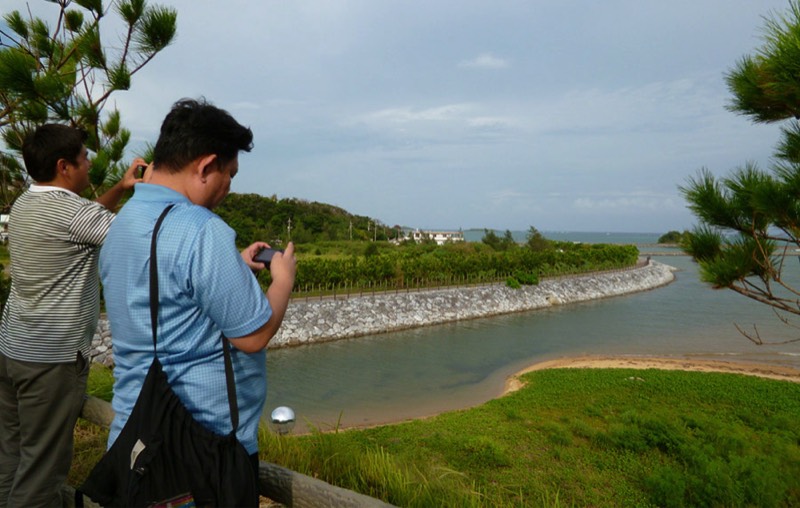
Okinawa’s natural environment is threatened
Information From the Ground
De La Salle University, the Philippines
Ordinary lectures in a regular classroom setting work well, but they are sometimes no match for learning in an actual setting, getting the latest information directly from the people concerned right there on the ground. Through this program, participants did not just get a glance, but also truly felt the promotion of conflict resolution and the advocacy of promoting peace and human security. The study program showcased a balance of lectures, together with field trips, and these covered a wide range of topics such as Okinawa’s history, its economy, the geography and culture, and the role of different agencies, both International organizations and non-governmental organizations in the advocacy of human security. The discussions included Peace and Stability in East Asia and Japan, the role of the U.S.-Japan Strategic Alliance, concepts and applications of peace building, social development and human security, and the hot topic of U.S. military bases in Japan.
In my past study of Japan, when it comes to Japanese history of war and peace, Hiroshima and Nagasaki prefectures are the ones usually highlighted. Through this program, my knowledge was widened and I came to understand the distressing role Okinawa played in Japan’s history and it ongoing crusade for peace today. With this as a backdrop, on the program we could feel first-hand the unease at the current situation, the torment many Okinawans feel about hosting enormous military bases in their tiny prefecture next to homes and schools. This program gave the opportunity for students from outside Japan to experience the nuts and bolts of keeping the peace in the Asia Pacific region and its affects on the Okinawa people.
Even though relatively brief, the information and knowledge gained from the study program was extensive. The esteemed lecturers, peace practitioners, and experts in their respective fields shared their understanding of the issues generously. The study program also paved the way for the creation of student networks; bridges were built and methods of communication were set up among the group. The round table discussions were such a good opportunity to gather minds for the sharing of information and ideas, we were able to speak personally and openly on certain issues from our own perspective. By identifying similar issues, views, or misunderstandings in our own countries through our comparative discussions, this brought clarity to topics. And with hearing direct assessments of situations from people living, or having lived or experienced human security torments, it was a completely sobering experience. This was learning at its most real and a brilliant alternative to the textbook and formal classroom. For me, it was when the cultural barriers were somewhat resolved or discussed, it was then that the issues we read in newspapers were pulled more sharply in focus.
Notwithstanding the lectures and discussion groups, the fieldtrips also played a meaningful part in the study tour. From Nakijin Castle to Shurijo Castle Park, the Okinawa Churaumi Aquarium, the Yanbaru bus tour to Okinawa prefectural museum; all of these where fascinating and brought clarity to lecture topics. Yet most thought provoking for me personally was the Peace Prefectural Museum. The names of over two hundred and forty thousand people who lost their lives in World War II are inscribed on the memorial. Each area of the museum mirrors Okinawa’s battles in what seems like waves of death, it is the starkest realization of the heartless effects of war.
Through the experience of the study tour, I now have a deeper and broader understanding of the sentiment of the Japanese people especially those who have witnessed the devastation and tragedy of war, things that have made Japan so peace loving. As well as this, I also know that the promotion of conflict resolution and advancing peace and human security is critically important in Asia, as well as on the world stage. I have no doubts about this. I got this information from the people right there on the ground.
In my past study of Japan, when it comes to Japanese history of war and peace, Hiroshima and Nagasaki prefectures are the ones usually highlighted. Through this program, my knowledge was widened and I came to understand the distressing role Okinawa played in Japan’s history and it ongoing crusade for peace today. With this as a backdrop, on the program we could feel first-hand the unease at the current situation, the torment many Okinawans feel about hosting enormous military bases in their tiny prefecture next to homes and schools. This program gave the opportunity for students from outside Japan to experience the nuts and bolts of keeping the peace in the Asia Pacific region and its affects on the Okinawa people.
Even though relatively brief, the information and knowledge gained from the study program was extensive. The esteemed lecturers, peace practitioners, and experts in their respective fields shared their understanding of the issues generously. The study program also paved the way for the creation of student networks; bridges were built and methods of communication were set up among the group. The round table discussions were such a good opportunity to gather minds for the sharing of information and ideas, we were able to speak personally and openly on certain issues from our own perspective. By identifying similar issues, views, or misunderstandings in our own countries through our comparative discussions, this brought clarity to topics. And with hearing direct assessments of situations from people living, or having lived or experienced human security torments, it was a completely sobering experience. This was learning at its most real and a brilliant alternative to the textbook and formal classroom. For me, it was when the cultural barriers were somewhat resolved or discussed, it was then that the issues we read in newspapers were pulled more sharply in focus.
Notwithstanding the lectures and discussion groups, the fieldtrips also played a meaningful part in the study tour. From Nakijin Castle to Shurijo Castle Park, the Okinawa Churaumi Aquarium, the Yanbaru bus tour to Okinawa prefectural museum; all of these where fascinating and brought clarity to lecture topics. Yet most thought provoking for me personally was the Peace Prefectural Museum. The names of over two hundred and forty thousand people who lost their lives in World War II are inscribed on the memorial. Each area of the museum mirrors Okinawa’s battles in what seems like waves of death, it is the starkest realization of the heartless effects of war.
Through the experience of the study tour, I now have a deeper and broader understanding of the sentiment of the Japanese people especially those who have witnessed the devastation and tragedy of war, things that have made Japan so peace loving. As well as this, I also know that the promotion of conflict resolution and advancing peace and human security is critically important in Asia, as well as on the world stage. I have no doubts about this. I got this information from the people right there on the ground.
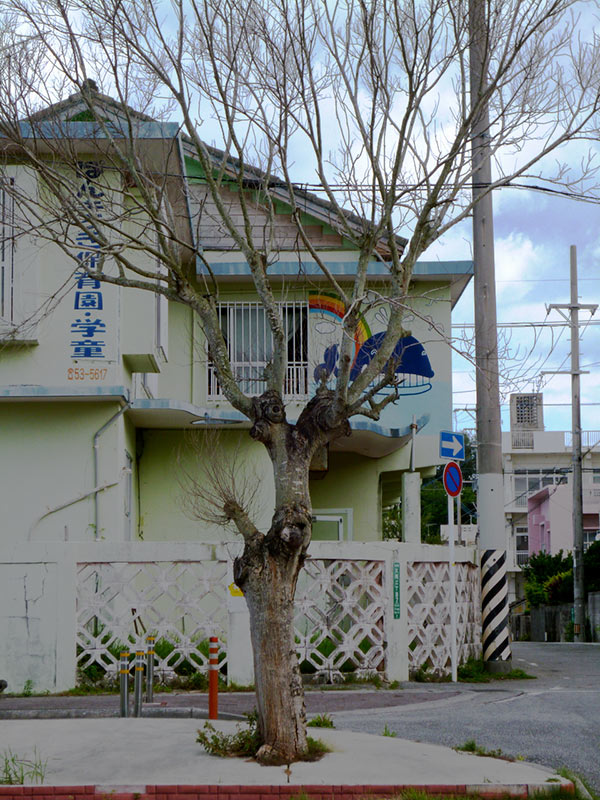
“Okinawa: An ongoing crusade for peace”
PAHSA is part of "Campus Asia." Supported by the Ministry of Education, Culture, Sports, Science and Technology in Japan
Download the PAHSA Brochure
PAHSA sister sites
.gif)


